11 best Montessori toys for baby’s first year

Montessori is all about tapping into a child’s natural inclination to learn. The classic toys that Montessori methods inspire are favorites of ours for this reason. Here are 11 of the best Montessori toys for a baby’s first year, along with some tips on how to use them.
High-contrast ball for grasping, transferring, & rolling
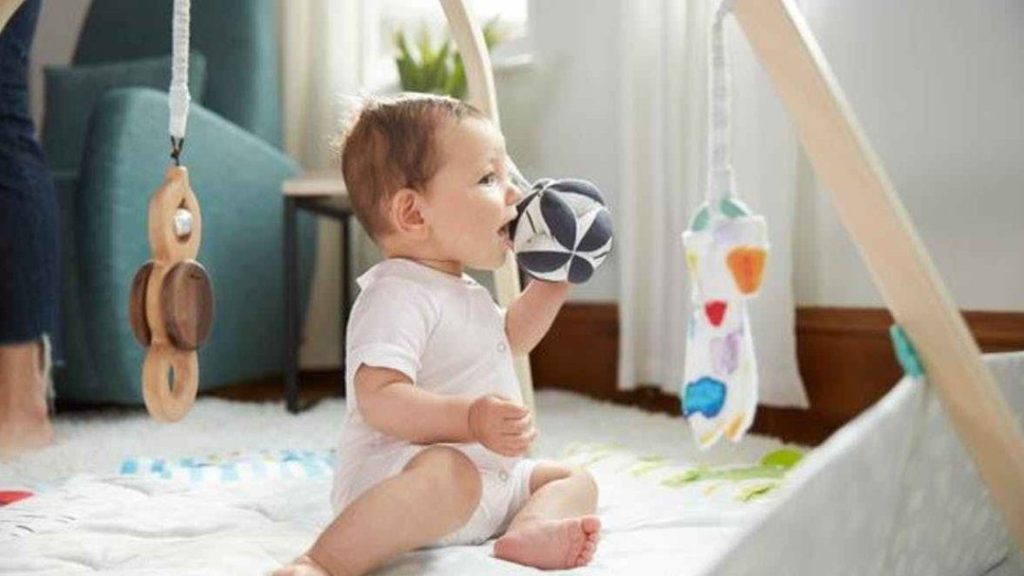
The soft Montessori ball is thoughtfully designed to be easy for babies to grasp and move. Moving a ball from one hand to the other is an important skill that your baby will develop — one that requires dexterity and enhanced coordination across his body. We recommend organic cotton for safe mouthing.
Ideas for play:
- Practice eye tracking with babies 0 – 8 weeks by slowly moving the high contrast ball in front of your baby’s view.
- During tummy time, have your baby reach for, grasp, grip, squeeze, and mouth the ball.
- Roll the ball back and forth in front of them to begin learning about how spheres move.
- At the end of month 6, your baby may be able to find objects that you partially hide under a blanket, pillow, or furniture. You can start to play hide-and-seek with the ball.
Classic wood rattle for tracking sounds

Sometime in month 4, your baby will start to look for and track the sources of sounds he hears. They’ll recognize the sound of his rattle, for instance, even when there are other noises in the background. Understanding that objects (and people!) can make sounds is an early lesson in cause and effect. This classic rattle is made with sustainably harvested wood and safe non-toxic water based paint.
Ideas for play:
- Shake the rattle near your baby’s face; keep rattling while moving it past their eyes until they notice the rattle’s making a sound and starts tracking the sound with their eyes.
- For an early lesson in math, shake the rattle in a rhythm—e.g., Shake, shake, pause; shake, shake, pause—and then vary the pattern. Your baby will soon be able to tell the difference between the number of shakes they’re hearing.
- Help your baby shake the rattle and learn that two shakes feels different from three—this helps them start building associations between numbers, sounds, and movement.
Hand-to-hand transfer discs for both sides of the brain

Passing an object between two hands is a step babies work toward for months—getting it right involves coordination across the center of his body. Skilled hand-to-hand transfer won’t happen until sometime between months 5 and 7. It’s the basis for later motions such as self-dressing, eating with utensils, holding crayons, and running. These joined discs are a Montessori classic: they help babies practice manipulating an object in one hand and eventually passing it to the other.
Ideas for play:
- At first, your baby may grasp other things (like rings or rattles) while struggling with the discs, since holding them requires them to build up new fine motor skills.
- Holding the discs by month 4 is a major accomplishment for any baby—don’t worry if it takes some practice!
Rolling bell to encourage rolling and scooting

When your baby plays with this classic Montessori rolling bell, they discover new ways to coordinate their senses: the feel of the wood when they’re grasping it, the sound it makes when you or they roll or shake it, and how it moves when it’s rolling along.
Ideas for play:
- Roll the bell just out of reach during tummy time to encourage your baby to reach and scoot.
- Use the bell to encourage them to roll over.
- Lay your baby on their back and place the bell just out of reach.
- Make the bell ring.
- Watch as they pull their legs up and starts to roll over to the side where the noise just came from—and eventually all the way over onto their belly.
Classic first puzzle for fine motor and problem solving

The first circle puzzle helps your baby develop fine motor and problem solving skills—their hands and eyes work together when they remove the puzzle piece. They’re also working on shape recognition at the same time. The circle shape is the best for first learners. We love this puzzle because it’s made with sustainably harvested wood and has a baby friend inside.
Ideas for play:
- Long before your baby learns how to put the puzzle piece in, they can pull it out.
- Have your baby practice grasping the knob and pulling the piece out and then show them how it fits back in.
- Let your baby explore the two parts of the puzzle by mouthing them and banging them together—banging objects together requires your baby to use both sides of the body at once, a very important skill.
- You can cut out and adhere pictures of family members or pets for a surprise inside.
Montessori cup to promote speech development

Offering real world glasses, cups and pitchers to babies is a long standing Montessori tradition. Speech pathologists agree—they prefer babies to use open cups when possible, as they help babies build the muscles in the mouth that are used to form sounds (and also lessen drooling).
Ideas for play:
- Introduce the cup to your baby once they’re eating finger foods.
- Start with water, and model drinking from the cup for your baby.
- At first, your baby may just pour the water out, or drop the cup on the floor—they’re learning about pouring, containing, and gravity by doing this (remember that the next time they drop something messy!).
- Keep introducing the cup with a small amount of water at mealtimes and eventually they will begin to enjoy drinking from it.
The Object Permanence Box – learning that out of sight doesn’t mean gone forever
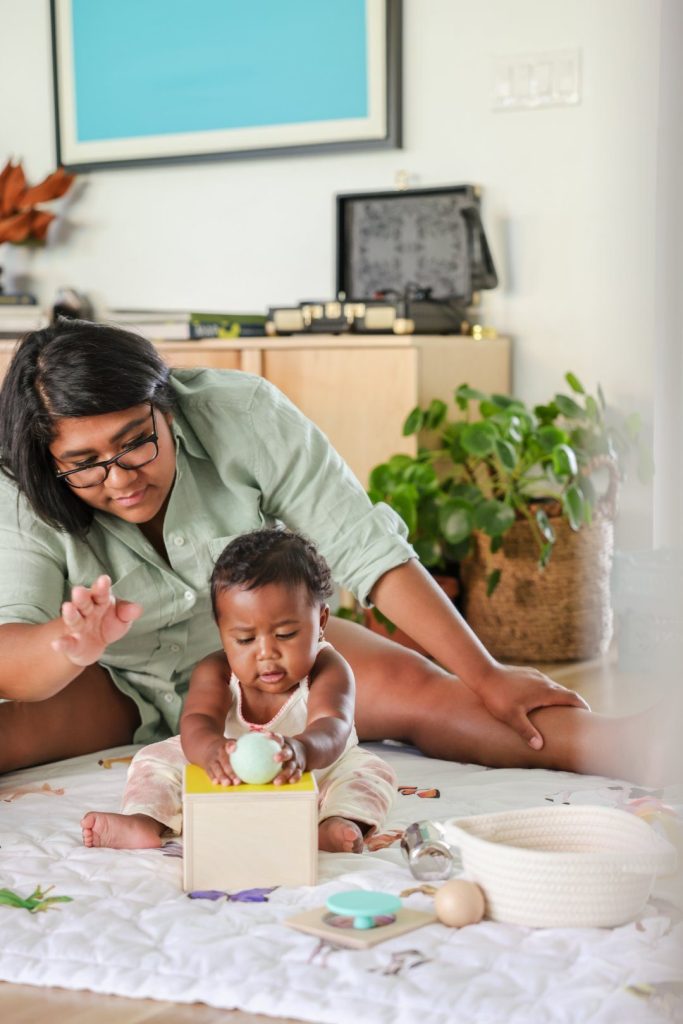
Between months 6 and 9, your baby can remember objects from one appearance to the next. A ball dropped inside the box is only gone for a moment—which helps your baby learn that when objects can’t be seen, it doesn’t mean they’re necessarily gone forever. This concept is called ‘object permanence’.
Ideas for play:
- First, show your baby how the box works by holding the ball and then dropping it through the hole.
- Help them try—if the ball misses the hole, see if they reach to try to get it.
- Resist getting the ball for them immediately—they will develop gross motor strength by reaching across their body while sitting.
- Your baby is practicing grasping and releasing on purpose as they try to drop the ball in the box (a skill they will continue to develop throughout his first year).
- If your baby doesn’t seem interested at first, try again later— babies learn to love the box at different times.
Treasure basket for new real world discoveries
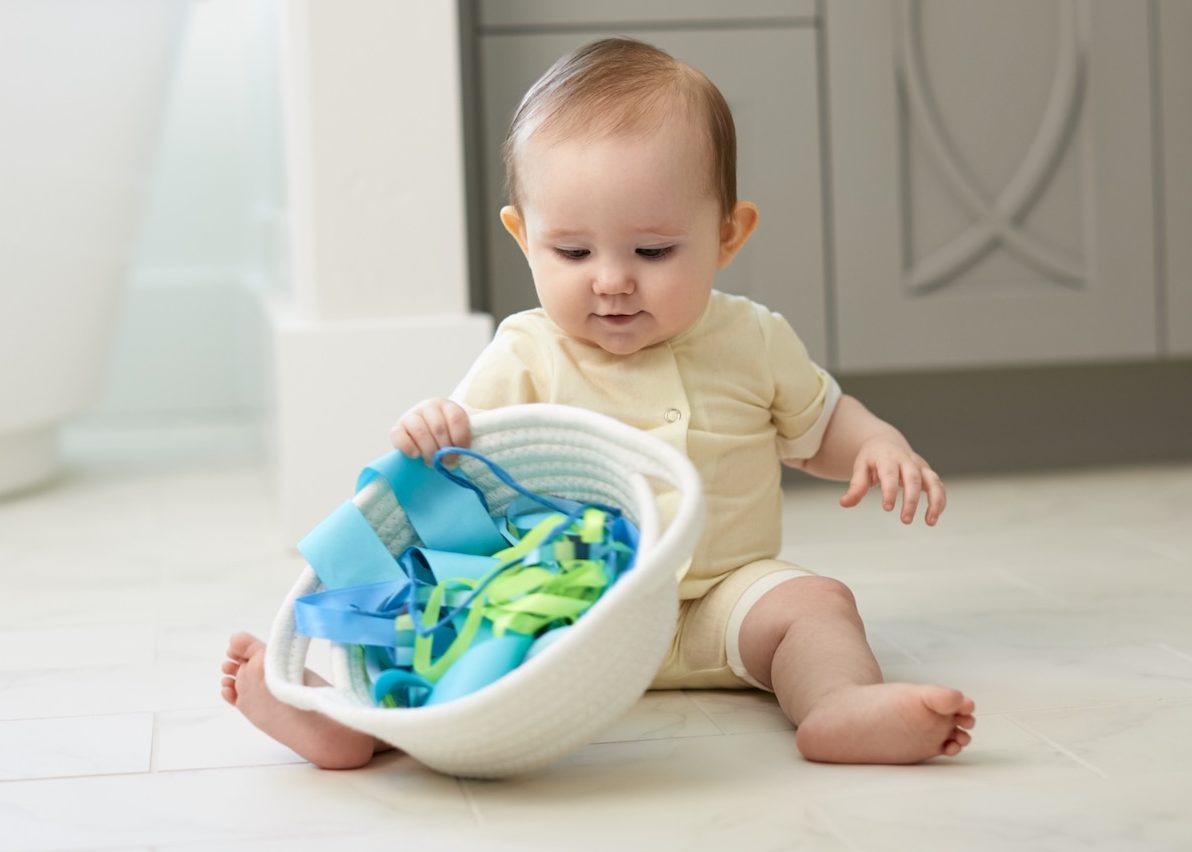
This Montessori classic encourages your baby to explore and make new discoveries independently. Your baby craves touching, handling, and mouthing new and different things (especially objects from real life). You’ll soon find out that there’s an endless stream of objects inside your home and outdoors that are often more interesting to them than actual toys.
Ideas for play:
- Place a few everyday objects in the basket
- Change the objects regularly to keep the basket interesting for your baby
- Think about categorizing types of objects—round things, square things, fuzzy things, things that jingle—to help him build associations
- Feathers, rocks (large enough that she can’t fit them in his mouth), pine cones, seashells
- Ribbons, pieces of fabric, large buttons
- A baby toothbrush, a makeup brush, a clean paint brush
- All sorts of balls! We especially love natural wool felt ones
- Note: Be sure to watch your baby so that small or crushable items are not mouthed. Also, pay attention when babies are around objects with handles, e.g., utensils such as whisks, brushes, and wooden spoons
Montessori Egg cup for building concentration and coordination
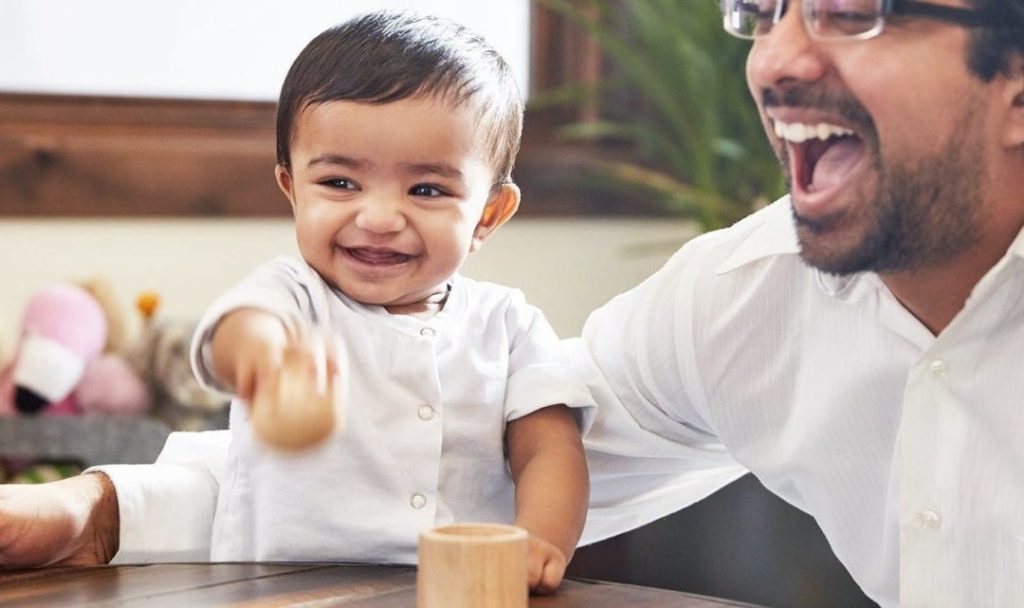
The wood cup and egg will help your baby learn to use both sides of their body at the same time—a skill that’s important for things like getting dressed. They need lots and lots of practice using both hands at once to build the speed of communication between their brain’s two hemispheres. As simple as it is, the egg cup is physically fascinating to babies.
Ideas for play:
- In the beginning, your baby will probably just enjoy banging the egg and cup together—this is also a way to use both sides of the body at once!
- See if they can dump the egg out of the cup at first— eventually they’ll work out how to put the egg in.
- Show your baby how to set the egg in the cup and then take it out again.
- Have your baby hold the egg in one hand, and the cup in the other, and encourage them to put the two parts together.
- Have them try to repeat your action—if they don’t, help guide their hands while standing or sitting behind them.
Pincer puzzle for fine motor skills
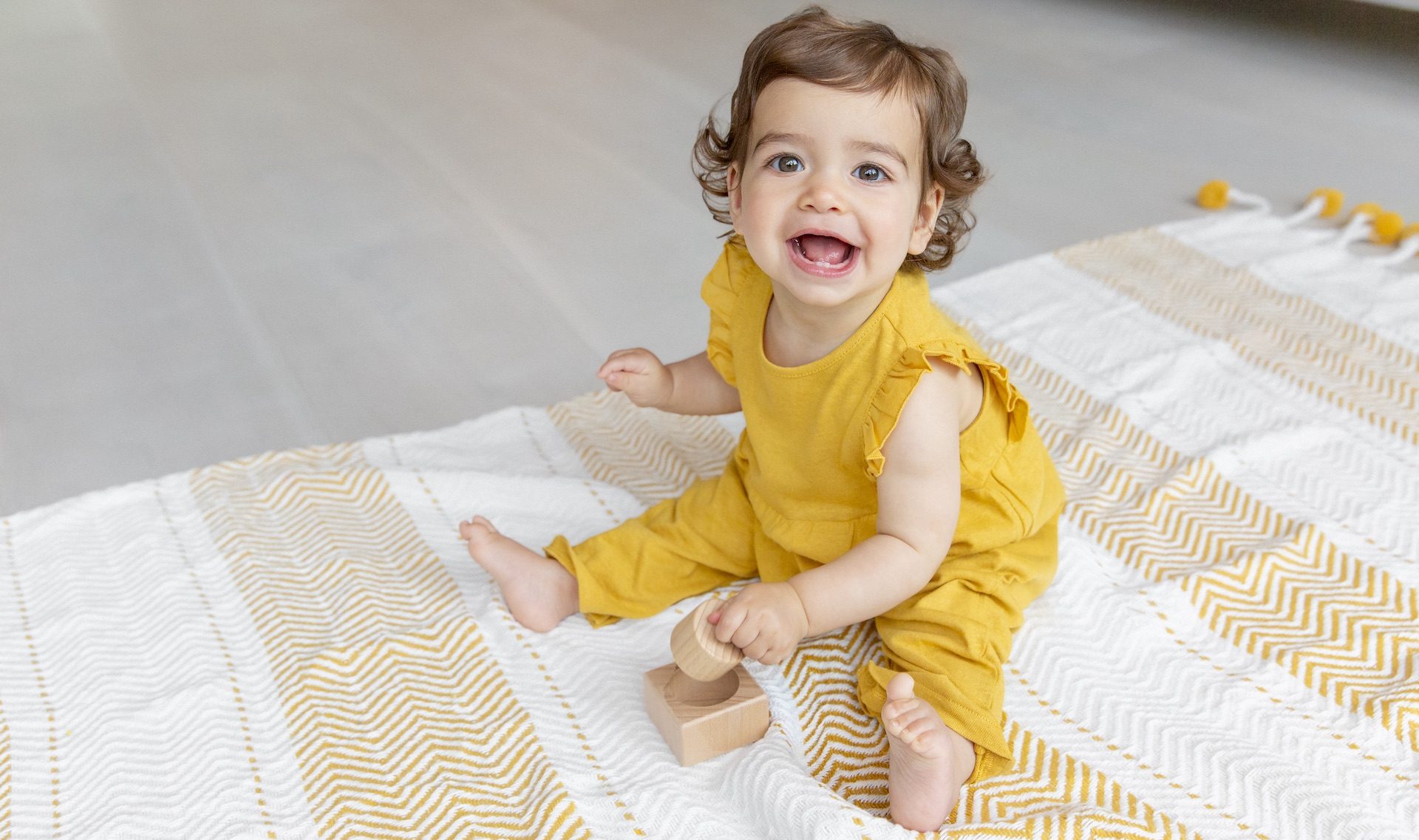
Between months 10 and 12, your baby learns to grasp small objects with their thumb and index finger—this is called the pincer grasp. This puzzle is designed to help him practice and reinforce this motion.
Ideas for play:
- Once you notice your baby trying to pick up small objects with two fingers like puffs or cereal, offer them the pincer puzzle.
- Guide their hand and explain how to remove the wood cylinder from the block, and how to put in back in.
Once your baby is playing with the puzzle confidently, set the block further away from the cylinder as a new challenge—one that works gross and fine motor skills at the same time.
Sliding top box for problem solving and hand and finger strength
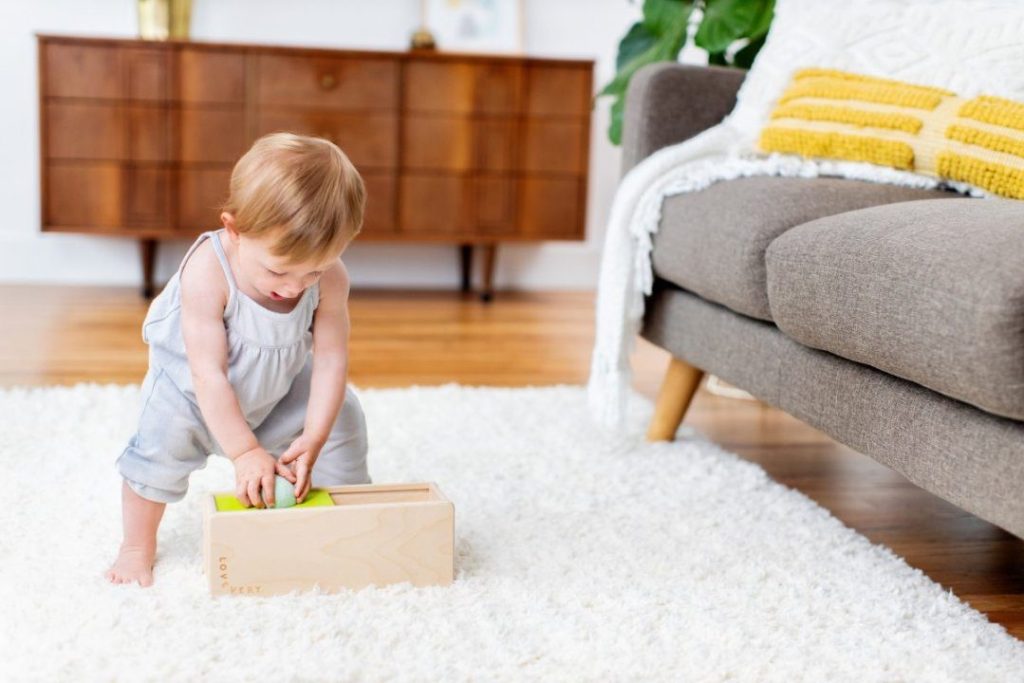
While your baby plays with the sliding top box, they’re building hand and finger strength as well as developing hand-eye coordination. They’re also working on problem solving skills—figuring out how to move the lid to find the ball inside.
Ideas for play:
- Let the ball drop into the hole, and ask your baby “Where did it go?”
- Let them watch you slide the lid to reveal the ball.
- You can drop other objects in the box—or put them in and slide the lid to hide them—your baby will be so proud when they can do this on their own!
See how Lovevery baby toys help with your baby’s development.

The Play Kits
The Play Kits by Lovevery are thoroughly tested, baby safe, eco-friendly and Montessori inspired. Give your child the best start with our stage-based play toy subscription boxes.
Learn more
The Play Gym
Lovevery’s award-winning, Montessori-inspired baby activity gym gives baby a whole year of play for their developing brain. See inside The Play Gym by Lovevery.
Learn more
Give the gift of Lovevery Play Kits
Our award-winning Play Kits, for ages 0–5, are tailored to match the child’s exact stage and include thoughtfully crafted play essentials, tips, and activities.
Learn moreKeep reading

13 - 15 Months
16 - 18 Months
19 - 21 Months
22 - 24 Months
The best Montessori and learning toys for 1 year olds
At 12 months old, your toddler is more mobile and curious than ever. The best toys support mobility, fine motor skills, language, and independence. See our best Montessori toys for 1-year-olds.

3-year-old
0 - 12 Weeks
3 - 4 Months
5 - 6 Months
7 - 8 Months
9 - 10 Months
11 - 12 Months
13 - 15 Months
16 - 18 Months
19 - 21 Months
22 - 24 Months
25 - 27 Months
28 - 30 Months
31 - 33 Months
34 - 36 Months
Why wooden toys make the best playthings
Wooden toys are a staple of Montessori learning. They're durable, beautiful, and inspire wonder for a child's budding imagination.

22 - 24 Months
25 - 27 Months
28 - 30 Months
31 - 33 Months
34 - 36 Months
Best Montessori and learning toys for 2 year olds
The best toys for 2 year olds support emerging independence and sense of identity. They also give your child opportunities for fine and gross motor practice, problem-solving, practical life skills, and more.

